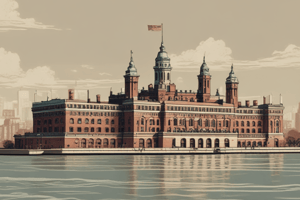Podcast
Questions and Answers
What regions have been the primary sources of immigration to the United States since the 1970s?
What regions have been the primary sources of immigration to the United States since the 1970s?
Asia, Mexico, and Latin America
What percentage of Los Angeles' population is comprised of foreign-born individuals?
What percentage of Los Angeles' population is comprised of foreign-born individuals?
One-third
What percentage of California's population is made up of racial minorities?
What percentage of California's population is made up of racial minorities?
One-fourth
What is the proportion of Americans who are members of a racial minority group?
What is the proportion of Americans who are members of a racial minority group?
What is the percentage of school children in 16 states and the District of Columbia who are racial minorities?
What is the percentage of school children in 16 states and the District of Columbia who are racial minorities?
What is the percentage of college students who are racial minorities?
What is the percentage of college students who are racial minorities?
What are the primary industries that have created millions of jobs in the United States, attracting large numbers of Latino and Asian immigrants?
What are the primary industries that have created millions of jobs in the United States, attracting large numbers of Latino and Asian immigrants?
What is the significance of California in relation to the current wave of immigration to the United States?
What is the significance of California in relation to the current wave of immigration to the United States?
What has contributed to the rapid growth of racial minorities in the American population?
What has contributed to the rapid growth of racial minorities in the American population?
What is the estimated number of Latinos living in the United States today?
What is the estimated number of Latinos living in the United States today?
What are the various subgroups that make up the Latino population in the United States?
What are the various subgroups that make up the Latino population in the United States?
What is the projected trend for the demographic makeup of the American population in the next century?
What is the projected trend for the demographic makeup of the American population in the next century?
What demographic change is projected to occur in the American racial minority population?
What demographic change is projected to occur in the American racial minority population?
How does the United States rank in terms of Spanish-speaking population?
How does the United States rank in terms of Spanish-speaking population?
What is the impact of reduced state and federal aid on racial minorities?
What is the impact of reduced state and federal aid on racial minorities?
What is a historical precedent for the current resurgence of xenophobia in the United States?
What is a historical precedent for the current resurgence of xenophobia in the United States?
What is the significance of the issue of multiculturalism in the context of American society's rapid demographic change?
What is the significance of the issue of multiculturalism in the context of American society's rapid demographic change?
What is the criticism leveled against the multicultural curriculum in higher education?
What is the criticism leveled against the multicultural curriculum in higher education?
Flashcards are hidden until you start studying
Study Notes
Immigration Trends
- Since the 1970s, a large number of Latino and Asian immigrants have arrived in the United States, surpassing the immigration from southern and eastern Europe in the late 19th and early 20th centuries.
- A third of new immigrants enter the United States through California, earning it the title of America’s new Ellis Island.
Demographic Shifts
- Racial minorities are the fastest-growing segment of America’s population due to high birth rates and immigration.
- One in four Americans are members of a racial minority group, with one in three school children and one in five college students being minorities.
Latino Population
- The number of Latinos in the United States has increased by 50% since 1980, with over 25 million Latinos currently living in the United States.
- Latinos are projected to surpass African Americans as America’s largest racial minority population.
- The United States now has the fifth largest Spanish-speaking population in the world.
Urbanization
- Predominantly Latino cities have emerged in America, such as Los Angeles, Houston, Chicago, New York City, and Miami.
- Los Angeles has the second largest population of Mexicans in the world, while Houston has the third largest.
Socio-Economic Challenges
- The economic dislocation of the last quarter-century has intensified racial intolerance, with people of color facing social ills like joblessness, poor education, and a punitive legal system.
- Xenophobia has resurged due to widening racial and class divisions, leading to anti-immigration legislation and hate crimes.
Multiculturalism
- The rapid demographic change in American society has highlighted the importance of multiculturalism and the need for a culturally diverse curriculum in higher education.
- However, the concept of multiculturalism has faced resistance, being labeled as "un-American" and heretical.
Studying That Suits You
Use AI to generate personalized quizzes and flashcards to suit your learning preferences.



